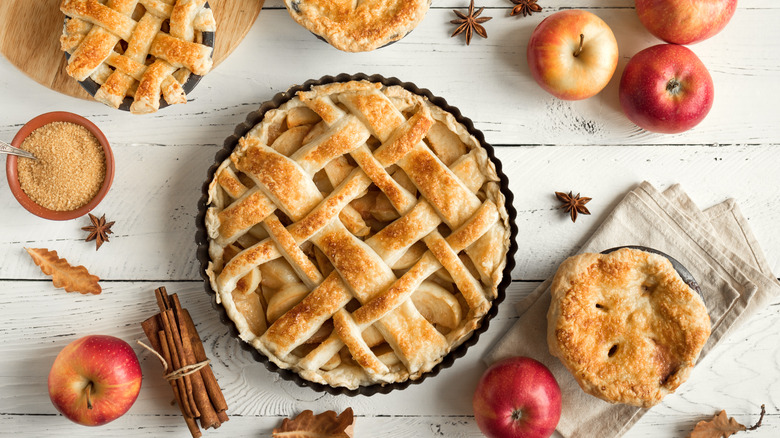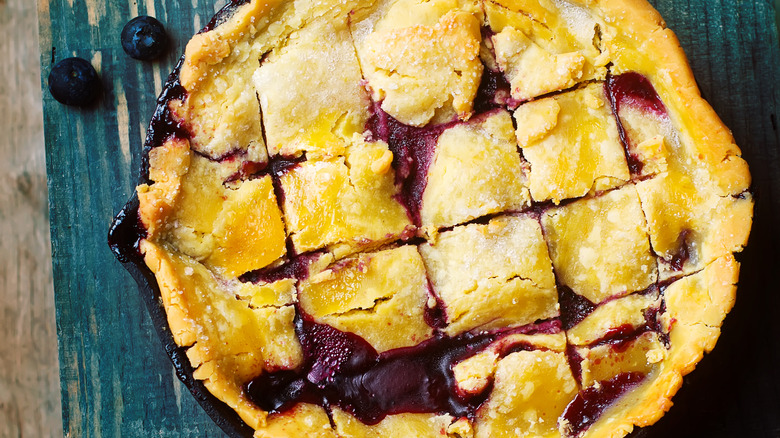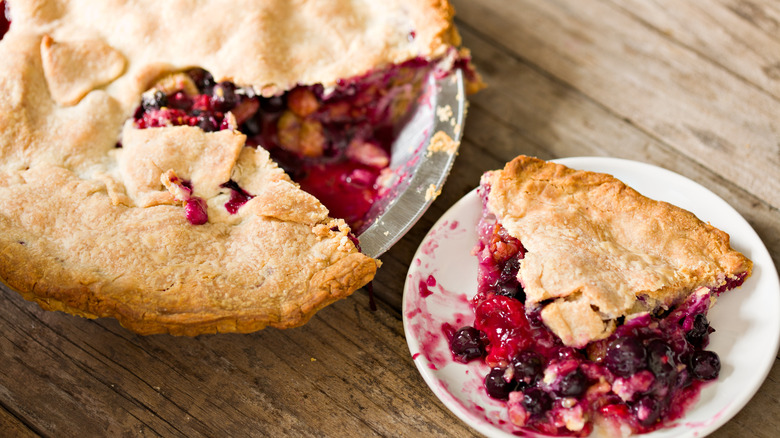The Differences Between Pan Dowdy And Pie
Whether you're making peach and blueberry in the summer or pumpkin and apple in the fall, baking a pie is a tasty labor of love. And yet, that's exactly what the pie-making process is like — laborious. Luckily, there are a plethora of alternate fruit-based desserts that are less finicky to make, such as cobblers, crumbles, crisps, and, of course, the pan dowdy (sometimes written as one word: "pandowdy"). It's less likely that you've heard of pan dowdies, but these bubbly treats are no less easy and delicious than the other pie alternatives.
Think of a pan dowdy as more like a cobbler than a pie. Instead of a carefully crafted lattice crust, a crimped version that requires sealing around the edges, or an open-faced pie that has no dough on top at all, the process of covering a pan dowdy is much more relaxed. In some cases, you may see a full pie crust — but instead of meticulously arranging it over your fruit, you'll be breaking it down with a spoon halfway through baking in a deep dish. Pan dowdies were most popular at the turn of the 20th century, although a well-known 1940s song titled "Shoo-Fly Pie and Apple Pan Dowdy" put a spotlight back on the dessert a little later. They may not be as aesthetically pleasing as a lattice crust — the word "dowdy" does mean "unkempt" or "unfashionable" after all — but they're yummy, fruity desserts that take a little less effort to make.
What is pan dowdy?
We know what separates a pan dowdy from a traditional pie, but how exactly do you make this old-fashioned dessert? You'll need to produce a soupy filling for both pie and pan dowdy, typically by mixing your fruit with sugar, cornstarch, and a little lemon juice. However, with a pan dowdy, your filling goes straight into an empty baking dish that's usually more than 2 inches deep — again, making it more like a cobbler than a pie.
Earlier recipes (meaning the ones from the early 20th century) call for laying one big piece of dough the size of the baking dish over the top of your fruit. Nowadays, you can also use store-bought pie crust if you'd like to achieve the same effect. If you go this route, you'll want to take your dessert out of the oven halfway through baking and break up the crust with a spoon. This allows the juices to bubble up and coat the dough before the pan dowdy goes back in the oven. Modern recipes, however, may say to cut your dough (or puff pastry) into squares and scatter them over your fruit. You can still press them down with a spoon halfway through baking to let the juices seep through, but it may not be as satisfying as cracking into a full crust with a spoon.
What makes a pie different than a pan dowdy?
Unlike pan dowdy, most pies are baked in a special pie dish that tends to be round and 1 ½ to 2 inches deep. Before the fruit mixture goes in, the dish gets coated with the bottom crust, which needs to be rolled out and lightly pressed onto the edges of the pie tin.
There are a few different ways that you can top a pie. Pumpkin pies, for example, are placed in the oven without any type of dough on the top. Others, like traditional chocolate cream pies, don't involve baking the filling at all and instead require chilling. If you're making a lattice crust (perhaps over an apple or peach pie), you'll want to cut your dough into strips and layer them strategically over the fruit. For a vented crust, you can use a knife or cookie cutter to cut small pieces out of the dough. All of this happens before the pie is baked — once it goes in the oven, it doesn't come out until it's completely finished. If you're not sure which option to pick, the decision comes down to how much attention to detail you want to give your dessert, your crust preferences, and, of course, what type of baking dish you have on hand.


